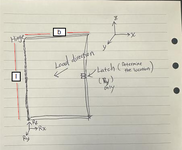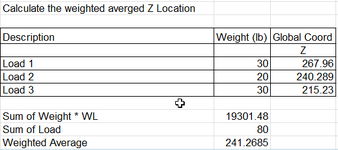Hello everyone,
I was wondering if I could analyze a door (hinge and latch) under load with classical hand analysis.
Boundary Condition: The door is hinged on one side, allowing rotation, while the latch will only react in the vertical direction (Ty).
Loading: Assume there will be 3 different loads at b/2, and various location along length l.
Goal: Determine where to place the latch to minimize the deflection in the y-deflection of the door.

I checked Roark's formula, but none of the boundary conditions match what I have here. Since the latch is assumed to be simply supported at a single location, and all the classical hand calculations assumed the entire edge is simply supported.
I will be modeling this in FEM, but I was wondering if it's possible to analyze this situation through hand analysis.
Any help is appreciated. Thank you!
I was wondering if I could analyze a door (hinge and latch) under load with classical hand analysis.
Boundary Condition: The door is hinged on one side, allowing rotation, while the latch will only react in the vertical direction (Ty).
Loading: Assume there will be 3 different loads at b/2, and various location along length l.
Goal: Determine where to place the latch to minimize the deflection in the y-deflection of the door.

I checked Roark's formula, but none of the boundary conditions match what I have here. Since the latch is assumed to be simply supported at a single location, and all the classical hand calculations assumed the entire edge is simply supported.
I will be modeling this in FEM, but I was wondering if it's possible to analyze this situation through hand analysis.
Any help is appreciated. Thank you!

